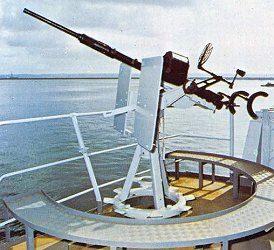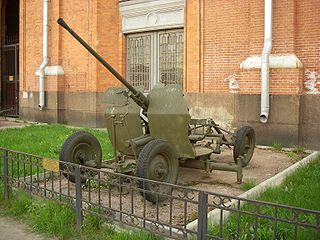
An anti-aircraft vehicle, also known as a self-propelled anti-aircraft gun (SPAAG) or self-propelled air defense system (SPAD), is a mobile vehicle with a dedicated anti-aircraft capability.

An autocannon, automatic cannon or machine cannon is a fully automatic gun that is capable of rapid-firing large-caliber armour-piercing, explosive or incendiary shells, as opposed to the smaller-caliber kinetic projectiles (bullets) fired by a machine gun. Autocannons have a longer effective range and greater terminal performance than machine guns, due to the use of larger/heavier munitions, but are usually smaller than tank guns, howitzers, field guns or other artillery. When used on its own, the word "autocannon" typically indicates a non-rotary weapon with a single barrel. When multiple rotating barrels are involved, such a weapon is referred to as a "rotary autocannon" or occasionally "rotary cannon", for short.

25 mm caliber is a range of autocannon ammunition. It includes the NATO standardized Swiss 25×137mm, the Swiss 25×184mm, the Soviet 25x218mmSR, and the Chinese 25×183mmB.

The 30 mm caliber is a range of autocannon ammunition. It includes the NATO standardized Swiss 30×173mm, the Soviet 30×155mmB, 30×165mm and 30×210mmB, the Czechoslovak 30×210mm, the Yugoslav 30×192mm, the British 30×113mmB, and the French 30×150mmB and 30×170mm cartridges.

The MG FF was a drum-fed, blowback-operated, 20 mm aircraft autocannon, developed in 1936 by Ikaria Werke Berlin of Germany. It was a derivative of the Swiss Oerlikon FF F cannon, with the Oerlikon FF design itself a development of the Imperial German World War I Becker 20 mm cannon, and was designed to be used in space-limited, fixed mountings such as inside aircraft wings, although it saw use as both an offensive and a defensive weapon, in both fixed and flexible format. It saw widespread use in those roles by the German Luftwaffe, particularly during the early stages of World War II, although from 1941 onwards it was gradually replaced by the Mauser firm's 20 mm MG 151/20, which was lighter, and had both a higher rate of fire and muzzle velocity.

The M242 Bushmaster chain gun is a 25 mm (25×137mm) single-barrel chain-driven autocannon. It is used extensively by the U.S. military, such as in the Bradley fighting vehicle, as well as by other NATO members and some other nations in ground combat vehicles and various watercraft. Hughes Helicopters in Culver City, California, was the original designer and manufacturer. McDonnell Douglas Helicopters acquired Hughes Helicopters in 1985, and merged into Boeing Corporation in 1997. In 2002, it was sold again to Alliant Techsystems, which merged with Orbital Sciences Corporation in 2015 to form Orbital Science ATK and was, in turn, bought out by Northrop Grumman in 2018. As of 2019, Northrop Grumman Innovation Systems produces the gun.

The Type 96 25 mm gun was an automatic cannon used by the Imperial Japanese Navy during World War II. A locally-built variant of the French Hotchkiss 25 mm anti-aircraft gun, it was designed as a dual-purpose weapon for use against armored vehicles and aircraft, but was primarily used as an anti-aircraft gun in fixed mounts with one to three guns.

The Oerlikon 20 mm cannon is a series of autocannons based on an original German Becker Type M2 20 mm cannon design that appeared very early in World War I. It was widely produced by Oerlikon Contraves and others, with various models employed by both Allied and Axis forces during World War II. Many versions of the cannon are still used today.
20 mm caliber is a specific size of popular autocannon ammunition. It is typically used to distinguish smaller-caliber weapons, commonly called "guns", from larger-caliber "cannons". All 20 mm cartridges have an outside projectile (bullet) diameter and barrel bore diameter of 0.787 inches (20.0 mm). These projectiles are typically 75 to 127 mm (3–5 in) long, cartridge cases are typically 75 to 152 mm (3–6 in) long, and most are shells, with an explosive payload and detonating fuze.

The Oerlikon GDF or Oerlikon 35 mm twin cannon is a towed anti-aircraft gun made by Oerlikon Contraves. The system was originally designated 2 ZLA/353 ML but this was later changed to GDF-001. It was developed in the late 1950s and is used by around 30 countries.
The Volkov-Yartsev VYa-23 is a 23 mm (0.91 in) autocannon, used on Soviet aircraft during World War II.

The Flak 30 and improved Flak 38 were 20 mm anti-aircraft guns used by various German forces throughout World War II. It was not only the primary German light anti-aircraft gun but by far the most numerously produced German artillery piece throughout the war. It was produced in a variety of models, notably the Flakvierling 38 which combined four Flak 38 autocannons onto a single carriage.

25 mm automatic air defense gun M1940 (72-K) was a Soviet 25 mm caliber anti-aircraft gun used during the Great Patriotic War. The gun was developed from the end of 1939 to the beginning of 1940 at 8th Kalinin Artillery Plant under the guidance of its Chief Designer Mikhail Loginov, supervised by Lev Loktev. The cannon was given the factory code 72-K before being accepted into service by the Red Army as the 25 mm automatic air defense gun M1940.

The KS-19 100mm anti-aircraft gun is a Soviet anti-aircraft gun that also features good capabilities against ground targets.

The HS.820 was a 20 mm caliber autocannon developed by Hispano-Suiza primarily for aircraft use, but more widely used in a series of ground-based anti-aircraft guns. After Oerlikon purchased Hispano's armaments division in 1970, the HS.820 became the Oerlikon KAD, supplanting Oerlikon's own KAA and KAB weapons in the process. A US-built model, the M139, saw some use on vehicles.

ZSU-37 was a Soviet-made, light, self-propelled anti-aircraft gun (SPAAG), developed by the end of 1943 and produced at Works No. 40 in Mytishchi. It was the first Soviet series-produced tracked SPAAG. ZSU stands for Zenitnaya Samokhodnaya Ustanovka, meaning "anti-aircraft self-propelled mount".

The Gryazev-Shipunov GSh-30-1 is a 30 mm autocannon designed for use on Soviet and later Russian military aircraft, entering service in the early 1980s. Its current manufacturer is the Russian company JSC Izhmash. The name GSH-30-1 is formed from the surnames of the designers Gryazev (Грязев) and Shipunov (Шипунов), the caliber of 30 mm and the single-barrel design of the gun itself.

The Oerlikon KBA is a 25 mm (25×137mm) autocannon, developed as a close range multipurpose weapon for the mechanised battlefield, originally made by Oerlikon and currently produced in Rheinmetall Italia S.p.A. facilities. It is a positively locked breech, gas-operated cannon with a rotating bolt head and a dual-belt selective feed system taking a 25mm NATO cartridge. The rate of fire in burst mode is 600 rounds per minute but it can be adjusted electronically and reduced to single shot or a selectable range from 100 up to 200 rounds per minute.

The Type 08 is a family of eight-wheeled amphibious, modular armored vehicle developed by Norinco for infantry fire support, battlefield logistics, and quick reaction operations. Developed in the early 2000s, the modern Chinese vehicle family were produced for more than 6000 hulls and widely deployed by the People's Liberation Army Ground Force and People's Liberation Army Marine Corps.

The Type 09 is a Chinese self-propelled anti-aircraft vehicle manufactured by Norinco. It is armed with two 35 millimeter cannons and optionally two to four fire-and-forget infrared homing missiles. It started to gradually replace the predecessor Type 95 in 2009. Some military analysts designated the vehicle as Type 07, but the official designation was confirmed as Type 09 on the Theme Exhibition of the 90th Anniversary of Chinese People's Liberation Army in 2017.


















